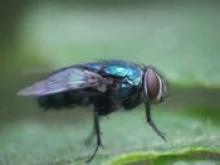If you’ve seen Steve Carell’s hilarious version of Get Smart, you know that the two geeky scientists, Lloyd and Bruce, come up with a very technologically-advanced version of a spy device: a robot fly designed to act like a real insect while gathering knowledge.
It turns out that Bruce and Lloyd weren’t onto something new.
Military scientists are currently developing insect cyborgs, or “cybugs,” to work as mini robot spies. So far, they have been successful controlling flying moths with actual tiny implants. Though they haven’t yet been able to attach miniature cameras to these tiny spies, they’re definitely working on it.
One problem has been being able to create an energy source that’s light enough to be carried but still powerful enough to be able to power high-tech equipment. Though it may sound like a dubious endeavor, if you’ve watched Bee Movie (or even a bee) you know that nature has already defied the laws of physics (which, considered that they’re created by man, are bound to fail sometime anyway) and enabled big-bodied insects to be able to carry themselves on the wind through flight when it would otherwise seem impossible.
Of course, that means that science is now trying to mimic nature in creating these cybugs—which, though copying nature is nothing new, is never perfect.
It’s also not the first time scientists have used bugs as inspiration for robots, having used grasshoppers, cockroaches and other insects as patterns before. The difference here is that instead of doing what Lloyd and Bruce did—spending billions on a tiny bug-like spy only to have it crushed to death—these scientists are going the cheaper route, using bugs already in existence and simply adding on parts to control and use them. Apparently they first tried to do this by gluing machines on their backs, but that plan was ditched for its unreliability—and sticky bugs.
Today the Hybrid Insect Micro-Electro-Mechanical Systems (HI-MEMS) Program is specifically dedicated to microchip implantation instead. What’s really creepy (besides essentially turning bugs into zombies, of course) is that the microchips are intertwined with the nerves and muscles of the bugs, making them super easy to control—and super easy to fear, I say, since what usually comes after animal experimentation?
Human experimentation!
Of course, it hasn’t come to that—at least, not as far as we know. So far, the program’s spent about $12 million on researching roaches, horned beetles and moths used as cybugs since 2006.
